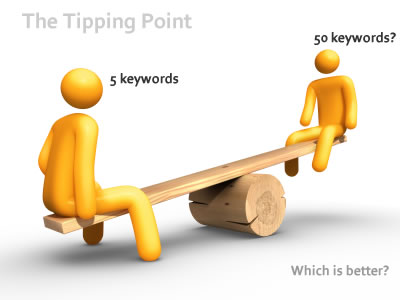Search Engine Optimization (SEO), is all about understanding the subtle balance and nuances of action and reaction, cause and effect to successfully manage the tipping point for hundreds of keywords that deliver visitors to your website.
Understanding the tipping point implies:
- How many pages are needed?
- How many links does it take to acquire, support and maintain a top ranking keyword?
- How much time will it take to see results?
Each factor varies….However, one thing is certain, the need to have a constant vigil while measuring the results of granular changes to determine how they impact the grand scheme of things.
Creating relevance through on page factors
With on page SEO, you can either bulldog your way to the top with brute force or use gradual finesse to acquire a top 10 position. Depending on your method and initial and sustained approach determines just how much time, energy and maintenance is required to keep the primary ranking factor fresh, while staving off competition for those keywords.
For example, if we use internal link mapping or internal link optimization as an on page tool to sculpt the way link weight moves throughout a website, this is like going back to move forward.
This type of optimization is crucial for most websites (since they lack any continuity whatsoever prior to optimization. Typically, this must be done on some level to maximize the leverage of aged pages with trust that have made the grade and stemmed authority status.
However this process implies that (a) you must evaluate which links would serve which pages (b) optimize the anchor text, the proximity of the links (body content is better than footer links or links on a sidebar or sub navigation) and (c) play the waiting game for search engines to re-index your content to see results.
Sure, you could wing it, make random guesses and see marginal results, but if you really dig into this tactic alone, you can rank higher for more keywords with less links from other websites. Essentially baking your SEO into the mix from the onset vs. trying to go back and “fix what is broken”.
Combined with the next layer of Off page SEO, somewhere in the balance between topical relevance, internal links and the volume of content on a topic is the tipping point. Once crossed, any type of related search can appear in the top 10 results with a fraction of the time, effort and energy.
Getting links, how many, how fast and why?
Once you (a) establish the tipping point (b) internally link your strongest pages, now what? Then its time to give your SEO a jump start to see how it fares against other websites.
This on page SEO was like tilling the soil to stir up ranking factors the off page SEO serves as fertilizer to provide sustenance to the on page factors to make each page transcend itself and add to the overall ambient ranking factor of the website.
Just like the sum is greater than the parts, each page can transcend itself and lend itself to ranking multiple keywords instead of the ones it was originally intended for. Much of this is a side-effect of deep links (links to other pages other than the homepage) and balancing the deep link ratio.
Two things about links (1) keep it natural and (2) better to vary the anchor text and how you concentrate the off page theme of the site. Natural implies that you do not gain 1000 links in one month with the same anchor text (that could signify automation and potentially trip a filter).
On the contrary, take a look at the #1 spot for the keyword, see how many pages the competitor has within their site, see if it is a page deep linked or if it is the “catch all” home page brandishing the ghost ranking afterglow of link weight rising to the top of the site (like a balloon).
If it is a page, then you can determine (1) how many links are supporting that page (both internally and externally), then (2) determine how far the website you are fine-tuning is on a comparative scale. For example, they have 200 pages on Topic A which supports Keyword A, B and C, then you had better get busy adding relevant content to increase relevance. If they have 100 links to the page which is ALL ABOUT THAT TOPIC and you have 1 link, then you need more deep links, etc…
The thing to consider is, spreading the ranking factor across multiple areas instead of just targeting a keyword with tunnel vision. So often, prospects approach us with the misunderstanding that just by getting that ONE keyword, that they have won the ranking war.
In the same time it takes to optimize 1 keyword, you could have optimized 30 less competitive keywords which have a higher yield of aggregate traffic. So, tact, method and approach (optimizing an entire range of related keywords that overlap) dilute the risk of the endeavor.
The on page and off page optimization are just the mechanical components of mastering the keyword tipping point, the real understanding and benefit comes as a result of the site ranking for your main intentional keywords as well as thousands of unintentional long-tail keywords or other phrases that allow you to find which phrases have the highest conversion (after assessing the analytics).










Great article. Thanks for the information.
Hi..
Nice article, very informative thanks for posting it on the net, could be of great source of reference.
Thanks..
John..
great post